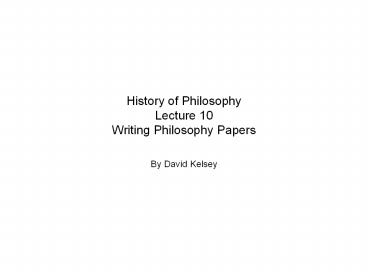History of Philosophy Lecture 10 Writing Philosophy Papers - PowerPoint PPT Presentation
1 / 14
Title:
History of Philosophy Lecture 10 Writing Philosophy Papers
Description:
History of Philosophy Lecture 10 Writing Philosophy Papers By David Kelsey Guidelines Here are some general guidelines for writing a philosophy paper: 1. – PowerPoint PPT presentation
Number of Views:349
Avg rating:3.0/5.0
Title: History of Philosophy Lecture 10 Writing Philosophy Papers
1
History of PhilosophyLecture 10Writing
Philosophy Papers
- By David Kelsey
2
Guidelines
- Here are some general guidelines for writing a
philosophy paper - 1. Your philosophy paper will make an argument.
- 2. The philosophy paper you will write in this
course will be of 2 kinds - a. The positive approach
- b. The negative approach
3
Keep it modest starting the writing process
- 3. Keep the scope of your paper modest.
- 4. How do you start the paper writing process?
- Read and think about it
- Work backwards
4
Start early be simple
- 5. Start the paper early, at least a few weeks in
advance of the due date. - Finding your thoughts on a subject can be
difficult. - 6. Be Simple
- Simple straightforward prose
5
Make the structure obvious and Be concise yet
fully explain
- 7. Make the structure of your paper obvious
- 8. Be concise yet fully explain
- Cover one or two small points but do fully
explore them
6
Chuck out whats unnecessary
- 9. Chuck out unnecessary paragraphs
- Each paragraph should be necessary in making your
argument - Each sentence should be a necessary part of its
paragraph - Each word should be a necessary part of its
sentence
7
Avoid vagueness and ambiguity, anticipate
objections editing your draft
- 10. Avoid vagueness and ambiguity.
- 11. Anticipate objectionsImagine the reader of
your paper is a devils advocate in the worst
kind of way. - 12. Read and re-read your draft
8
Vagueness
- A vague statement is one whose meaning is
indistinct, imprecise or lacks details. - Degrees Vagueness isnt all or nothing. It
comes in degrees. - Apartment example
9
Clarifying vagueness
- Desirable vagueness sometimes vagueness is
actually desirable. - Being Romantic
- Clarify If we come across a vague statement we
can simply try to clarify the lack of detail or
indistinct-ness. - Job example
10
Vagueness and Propositions
- A vague statement
- it is unclear what proposition the sentence
asserts at all. - It could be any one of a number of propositions
11
Ambiguous Claims
- An ambiguous claim is one that is subject to more
than one interpretation. - Claim x
- ? ?
- P1 P2
12
Semantic Ambiguity
- A sentence that is semantically ambiguous is one
which contains an ambiguous word or phrase. - For example
- Fixing the ambiguous word
13
Syntactic Ambiguity
- A sentence is syntactically ambiguous when it is
ambiguous because of its grammar or the way it
has been structured or put together.
- When you have come across a semantic ambiguity
you can simply alter the grammar - Or you might need to re-write the claim
altogether.
14
Grouping Ambiguity
- Grouping ambiguity
- unclear whether some word in the sentence is
referring to a group or an individual. - Secretaries and Physicians
- Lawnmowers and dirt bikes































